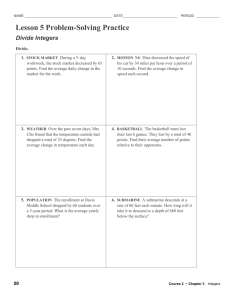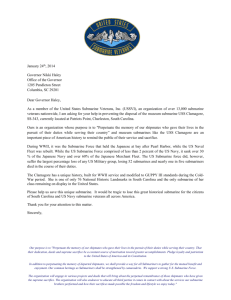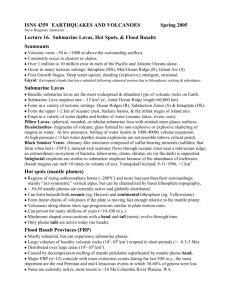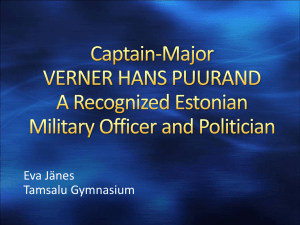Mil-Hist-WWII-Battle-of-Midway-Sub
advertisement
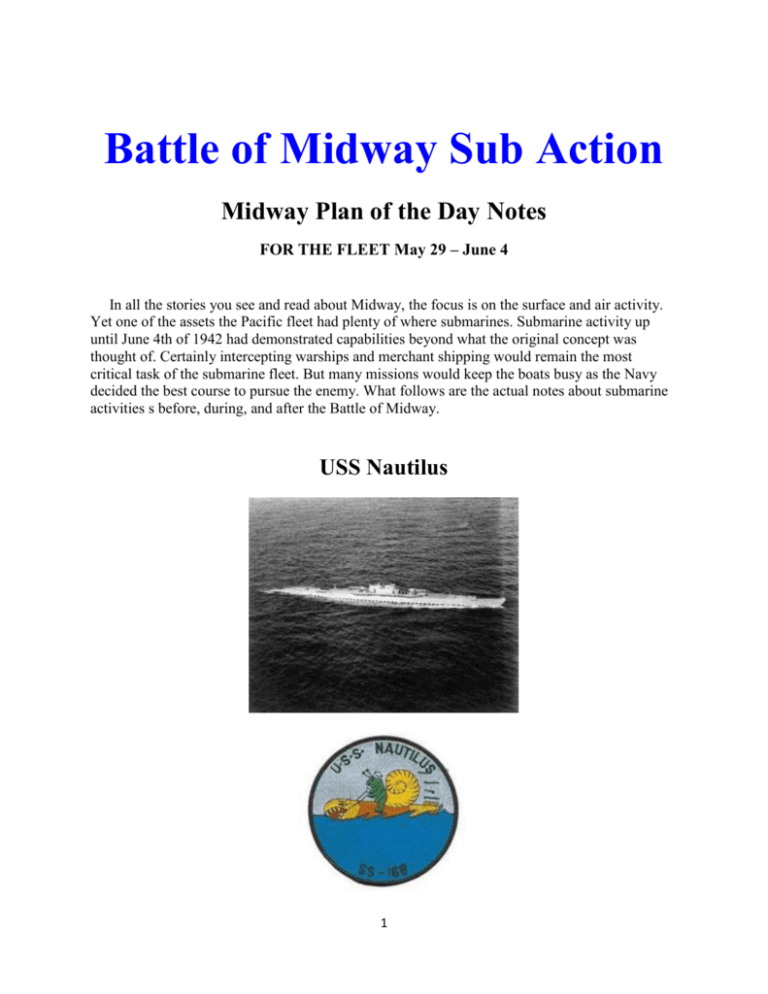
Battle of Midway Sub Action Midway Plan of the Day Notes FOR THE FLEET May 29 – June 4 In all the stories you see and read about Midway, the focus is on the surface and air activity. Yet one of the assets the Pacific fleet had plenty of where submarines. Submarine activity up until June 4th of 1942 had demonstrated capabilities beyond what the original concept was thought of. Certainly intercepting warships and merchant shipping would remain the most critical task of the submarine fleet. But many missions would keep the boats busy as the Navy decided the best course to pursue the enemy. What follows are the actual notes about submarine activities s before, during, and after the Battle of Midway. USS Nautilus 1 “Although LCDR William H. Brockman, Jr., CO of submarine Nautilus (SS-168), had been given command of the boat without the usual PCO training, he foresightedly ordered his radiomen to monitor the aircraft search frequency in advance of the time in the operations orders. Thus prepared ahead of time, Nautilus intercepted the contact report that told of the enemy’s proximity. Nautilus would find herself in the middle of the Japanese carrier force, and cause such consternation that the destroyer Arashi was detached to drive her off or sink her. Arashi’s haste to rejoin the main Japanese force attracted the attention of LCDR C. Wade McClusky, Commander, Enterprise Air Group, the former CO of VF-6, who decided to follow the enemy ship when he had not found the Japanese where expected. McClusky’s dive bombers and the Yorktown Air Group strike arrived almost simultaneously over the Kido Butai, and changed the course of the Pacific War soon thereafter.” From the war reports: At 07:55, 4 June, while approaching the northern boundary of her patrol area near Midway Island, she sighted masts on the horizon. Japanese planes sighted the submarine at the same time and began strafing. After diving to 100 feet (30 m), she continued observation. At 08:00, a formation of four enemy ships was sighted: the battleship Kirishima, the cruiser Nagara, and two destroyers (misidentified, as they often were early in the war, as cruisers) in company. Within minutes the submarine was again sighted from the air and was bombed. Two of the “cruisers” closed for a kill and nine depth charges were dropped at a distance of about 1,000 yards (910 m). When the attack ceased, Nautilus rose to periscope depth. Ships surrounded her. Sighting on Kirishima, she fired two bow tubes; one misfired, one missed. At 08:30, a destroyer immediately headed for the boat, which dove to 150 feet (46 m) to wait out the depth charge attack. At 08:46, periscope depth was again ordered. The cruiser and two of the destroyers were now out of range; echo ranging by the third appeared too accurate for comfort. At 09:00, the periscope was raised again and an aircraft carrier was sighted. Nautilus changed course to close for an attack. The enemy destroyer followed suit and at 09:18 attacked with six depth charges. USS Trout “As part of Admiral Chester W. Nimitz’s plans to meet the expected Japanese attack on Midway, Rear Admiral Robert H. English gave a dozen submarines the basic task of defending the atoll. One of those boats, Trout, had made three war patrols since the war began, and had an experienced commander, Lt. Comdr. Frank W. “Mike” Fenno, the oldest of all the submarine C.O.’s involved in the Battle of 2 Midway. Fenno’s boat had already earned fame for bringing out the gold from the Philippine treasury. While detection by Japanese planes forced Trout down several times, limiting her effectiveness, the boat rescued two Japanese sailors on 9 June 1942, survivors of the sunken heavy cruiser Mikuma, who provided much useful intelligence material. Her retrieval of the enemy bluejackets proved the precursor of more involved submarine rescue efforts as the war progressed.” The Trout completed 10 war patrols. On her 11th, she refueled at Midway Island before sailing off into history in February 1944. Japanese records indicate she was probably sunk in an attack on the 29th of February. She was carrying the Mk. XVIII electric torpedoes, and it was also possible that one of those had made a circular run and sunk the boat, as happened with Tang. On 17 April 1944, Trout was declared presumed lost with all 81 hands, including Commander Clark and his executive officer, Lt. Harry Eades Woodworth, both of whom had made all 11 war patrols. USS Tambor “Lt. Comdr. John W. “Spuds” Murphy, commanding the submarine Tambor, had been in command of that boat since the start of the war; Tambor had made two war patrols. During the mid watch on 5 June 1942, ignorant of the location of friendly forces, Murphy spotted four ships on the horizon that proved to be four Japanese heavy cruisers. When carrying out emergency evasive maneuvers, two of the enemy ships, Mikuma and Mogami, collided. Without firing a torpedo, Tambor had caused damage to two ships, one of which, Mikuma, was sunk by U.S. carrier-based planes on 6 June.” The main contribution the Tambor and her sister boats ended up being that the Japanese were forced to take her presence into account as they prepared for each part of the attack. Sadly, her commanding officer failed to pursue the enemy and was relieved of command upon return to Pearl Harbor. The boat itself went on to a great career in the Pacific and earned 11 Battle Stars. 3 USS Grouper “The new Gato-class boat Grouper, under Lt. Comdr. Claren E. “Duke” Duke, had yet to make a war patrol, and when attempting to get close enough to carry out an attack on the Japanese ships, found herself frequently under attack from aircraft. Diving to avoid one such attack on the afternoon of 5 June, Grouper plunged to an estimated 600 foot depth. The investigation for damage showed several electrical cables “pushed in a couple inches,” while cast iron plugs in the water manifolds for the generator coolers flew around the engine room “like machine gun bullets,” while water poured in through the stern tubes. The Mare Island Navy Yard product, however, proved tough, and survived the mishap, while “everyone had a few more gray hairs.” Grouper was assigned to the submarine screen which ringed the area as the American and Japanese fleets clashed in the decisive battle. Patrolling the fringe of the fighting 4 June, Grouper sighted two burning enemy aircraft carriers, but could not close for attack because of heavy air cover. On that day she was strafed by fighter planes and driven deep in a series of aircraft and destroyer attacks which saw over 170 depth charges and bombs dropped on the novice submarine. The next day, as the battle still raged, Grouper crash-dived to avoid heavy bombers. When you think about it, this was quite a baptism of fire for the boat. In addition to receiving ten battle stars, the Grouper went on to help the submarine force grow by serving as a great platform for development. Incredibly, she served until 1968 as an experimental platform. In the traditional sense, the twelve submarines present at Midway did not accomplish as much as they would later in the war. Many fault their positioning (close in rather than on extended patrol where they could have caught the enemy on their way in). The experience proved that a defensive posture for these boats would not gain as much as an offensive role. Problems with the torpedoes were still being identified and even if they had been in the proper position, there is no proof that they would have been any more successful. It would take dedicated work by Admiral Lockwood’s team to finally solve the mysterious issues that plagued the weapons. What is decidedly important though is that fleet submarine tactics were improved from that day and the Submarine Force continued to learn lessons that would make them the killing force that helped to turn the tide of the war. [Source: The Lean Submariner http://theleansubmariner.com/tag/uss-tambor Aug 2012 ++] 4


![[NI4331] Spaid Genealogy by A](http://s3.studylib.net/store/data/006715111_1-66565dd855c7f07f66414a20c8e82379-300x300.png)
